What is coloring
A small educational program to understand what's what. Coloring is a technique for dyeing hair, in which different shades are given to individual strands. They can be close to the native tone or, conversely, contrasting.
It all depends on the wishes of the client. But the selection of shades is a whole science, so only professionals who have undergone special training can do coloring.

Highlighting, which is often confused with coloring, can be called just one of its options.
- Highlight - this means to lighten some strands. In this case, only one shade is used.
- Coloring - these are more extensive and creative possibilities. You can also color in darker colors, as well as paint all strands in different shades.
Curious! Coloring hair (if you can call it that) first began in ancient Rome, when lime, talcum powder or ash of certain species of trees were used as pigments. The Romans loved the effect of the iridescent strands.

Pros of coloring short dark hair
- A short haircut is stylish and daring, but you can't really fantasize with it. You can do the styling on the other side, slightly raise the bangs and, in general, that's all. Otherwise, there is no variety. And to dilute such an image, girls often resort to coloring.
- If you color your short hair correctly, you can add visual volume to it. And this is another reason why short-haired women decide on such coloring.
- Yes, and a colored haircut will be easier to style: just run your fingers into your hair, beat them a little and sprinkle with varnish. And it will not look disheveled precisely due to the fact that the strands will have different shades.
You can color dark hair on any haircuts:
- hat (pot);
- square;
- bean;
- bob-square (including asymmetrical, like Olga Buzova's);
- pixie (like Audrey Hepburn in Roman Vacation);
- any haircut with artistic shaving of the temple (temples) or nape;
- page (like Lilia Gildeeva);
- short cascade or ladder;
- garcon (boyish);
- gavroche (tousled nape and elongated strands in the neck).
By the way! Another undoubted plus of coloring dark hair is the ability to paint over gray hair without resorting to cardinal coloring.
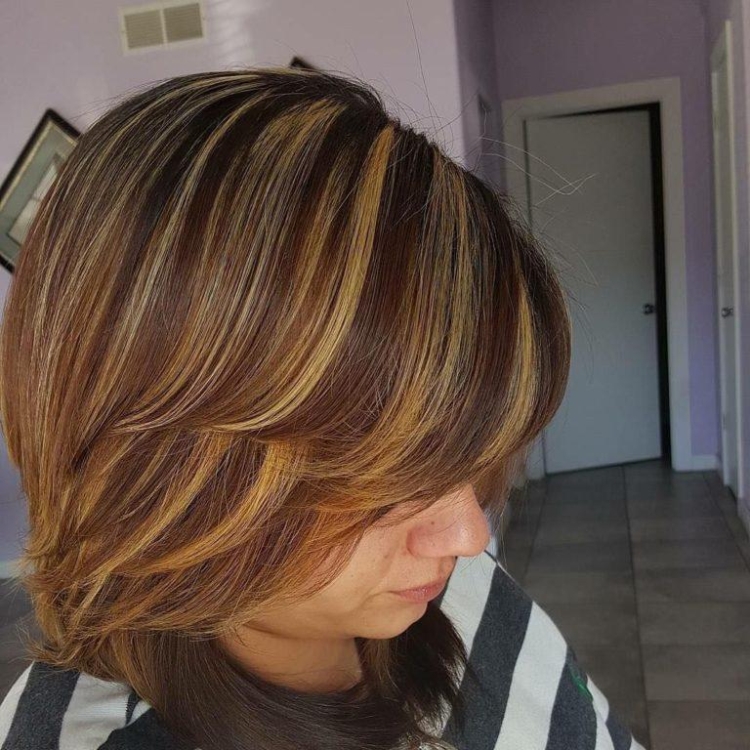
Peculiarities
Coloring technique is a complex process. It is often confused with highlighting, although this is a higher level of coloring. This is not only a complex gradation of one color, but also the technology of color dyeing of curls, and even a creative change in hair color.
Depending on the type of execution, coloring can be aimed at enhancing the color depth, creating the effect of burning strands or creative painting in the vertical and even horizontal direction.
When performing the technique, several color pigments are used. In this case, mixing of tones with different color temperatures is not allowed. This makes the haircut tasteless, if not completely vulgar. Compared to the usual length, dyeing short hair becomes more difficult.
In this case, a specialist often has to select a certain pattern and method, relying on the shape of the haircut and even its approximate styling.
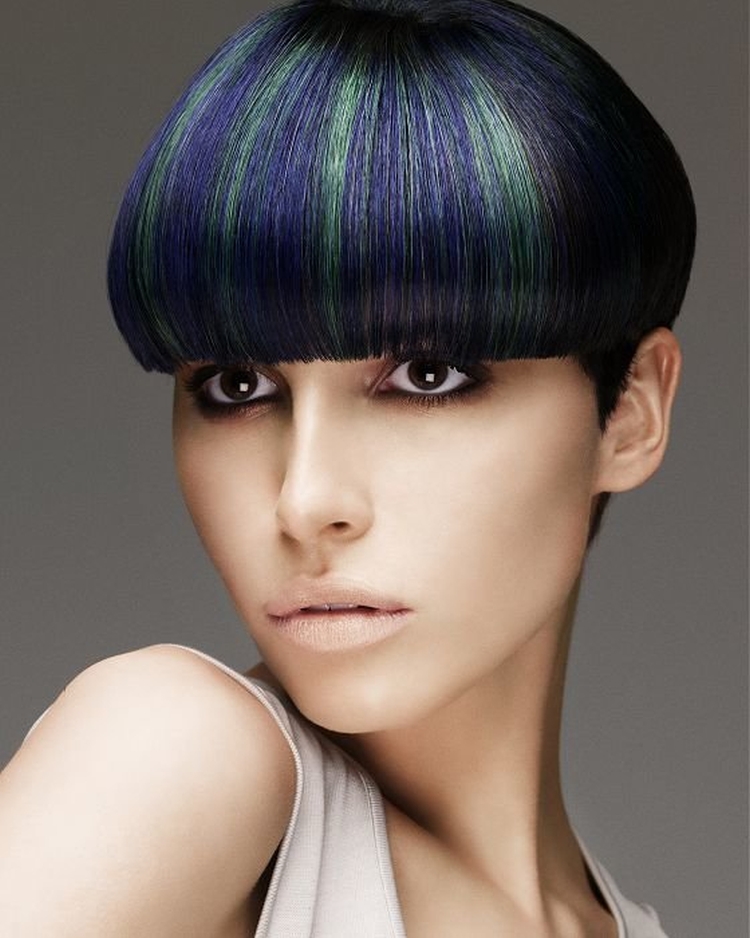
Short haircuts in themselves get everyone's attention.In order not to deprive the image of femininity and attractiveness, you have to pay a lot of attention to the choice of one or another type of painting. In fact, it can be complete (with coloring of the entire head of hair) or partial (when some part of the head is chosen for painting, for example, a bang or temporal region).
Depending on the wishes of the client and the characteristics of the structure of her hair, the stylist selects an option that suits her in terms of color and temperament.
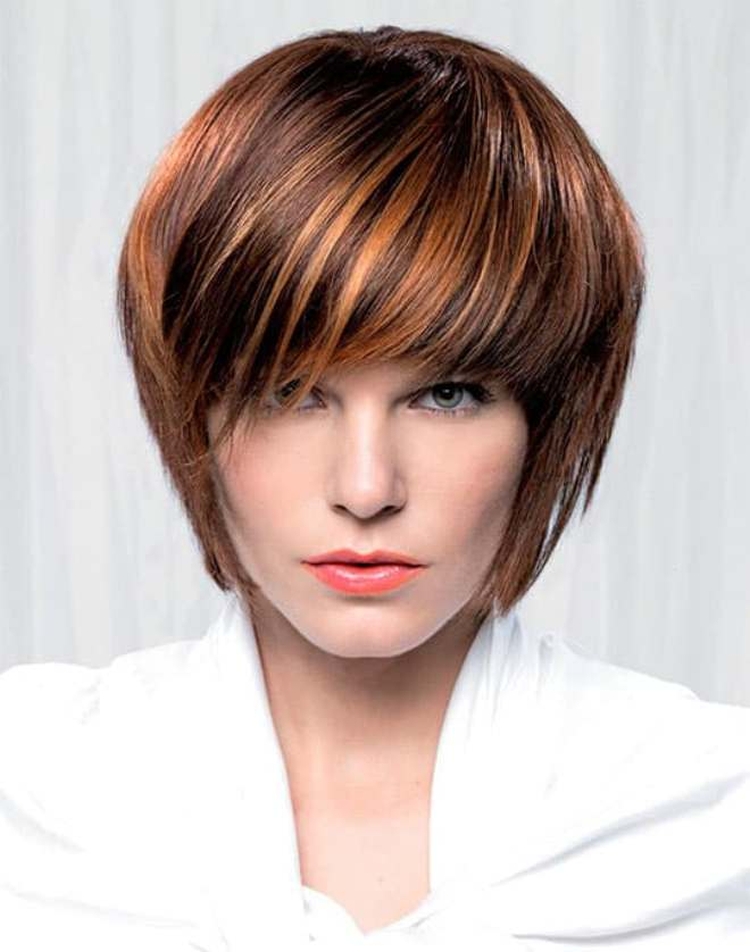
In addition, lifestyle, work, and individual interests are also taken into account. For example, for representatives of youth subcultures, the master can offer creative solutions with sharp contrasting colors. A business lady or office workers will be offered a harmonious and beautiful feminine coloring with the creation of soft transitions and blurred edges.
In this case, another decisive factor will be the type of paint, which can be ammonia or surface.
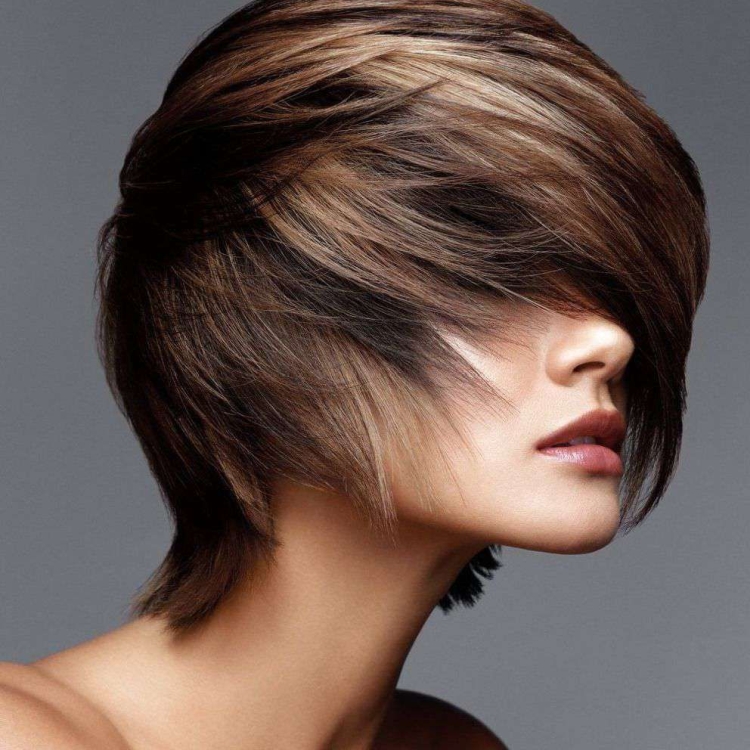
This technique differs from Air Touch by the greater thickness of the strands involved in processing. In addition, a hairdryer is not used for coloring. Here, the transitions can be sharp, and the number of shades often reaches 5-8. Coloring techniques are varied, depending on the choice of the right one, even the most seemingly simple haircut can be made unusual.
However, in order for the result to coincide with the desired, the selection of contrasting tones will have to be treated with special attention.
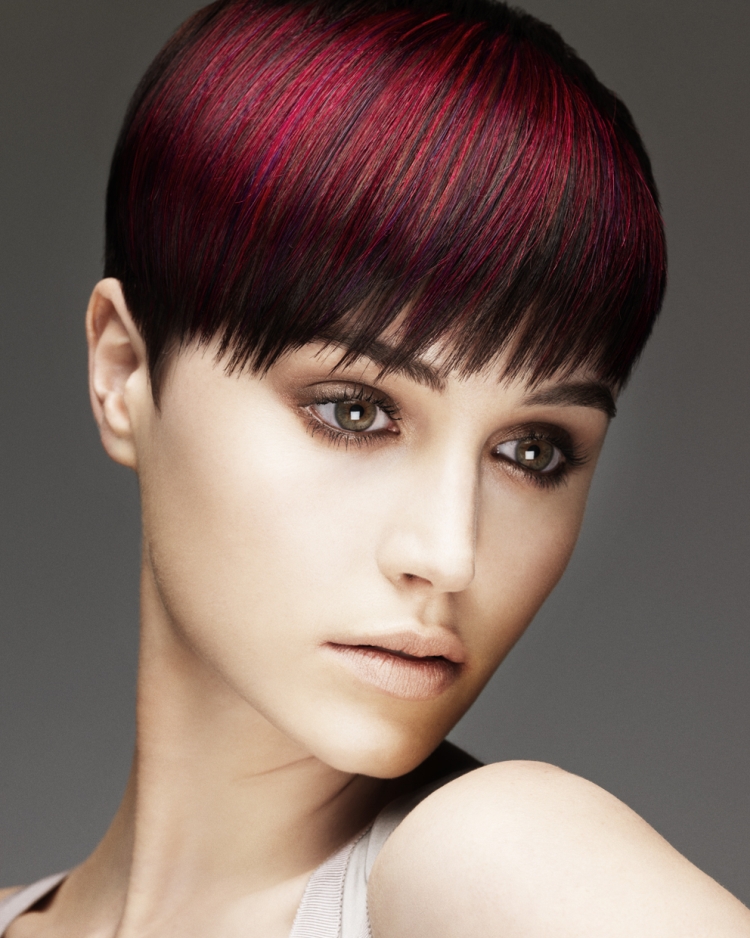
Coloring short hair is a great tool for masking thin hair that lacks volume. Due to the several shades involved in coloring, it creates the effect of versatility and splendor of the haircut. With him, she looks more interesting, fresher, more fashionable.
At the same time, the structure of the strands does not matter: on both straight and wavy hair of short length, coloring looks very impressive.
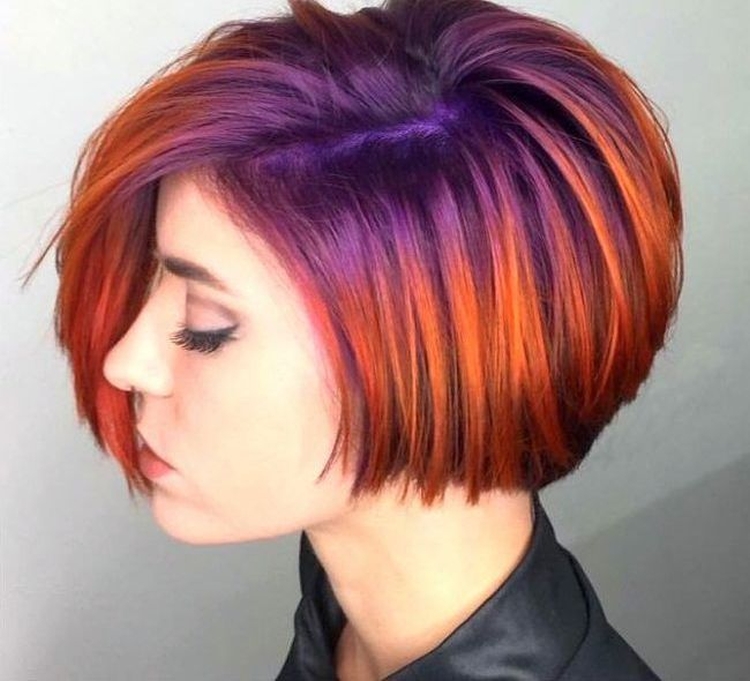
Varieties
It is possible to classify coloring for meek hair according to several criteria. For example, it can be neutral and colored. In addition, it is often performed using colorants that are related shades of the original base color. Based on the type of painting, it can be divided into longitudinal and transverse.
- American coloring it is noteworthy that at least 5 shades are used for it, suitable for the natural color of the curls.
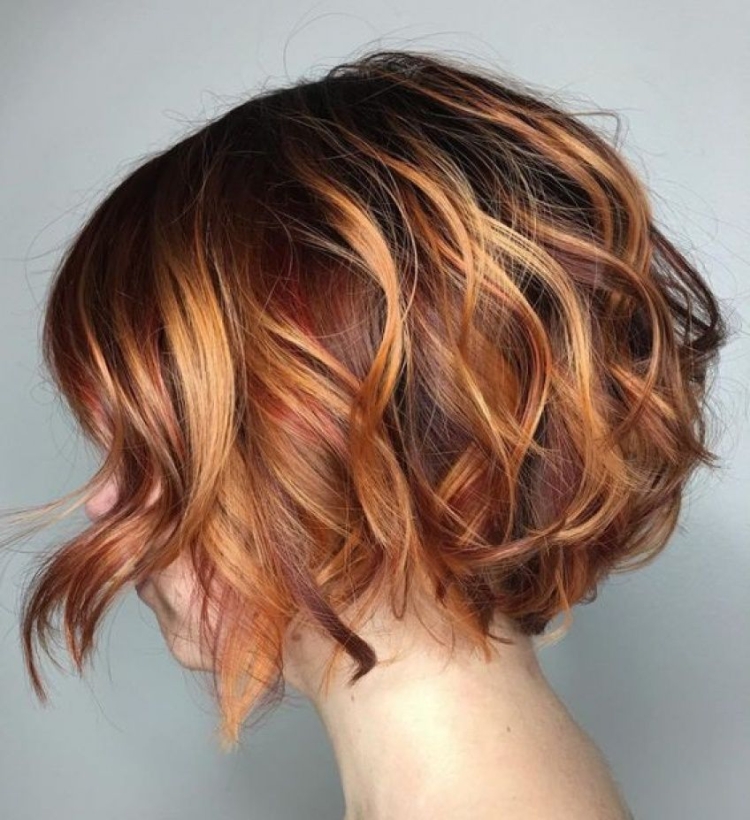
- Methodology "salt pepper" relevant primarily for gray-haired women and blondes. Here the roots are highlighted, and the ends, on the contrary, darken.
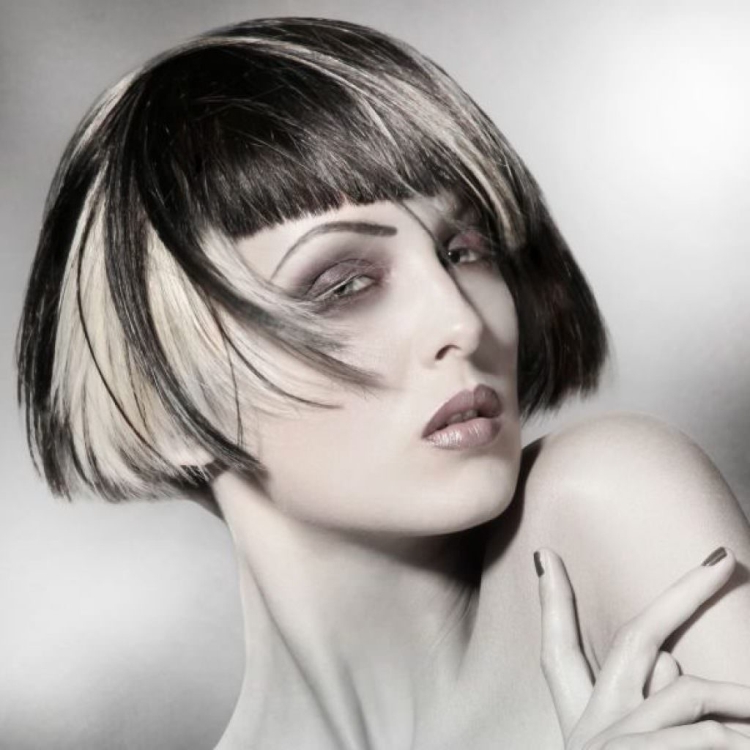
- Multitonal coloring is good for hair of any color and can be very diverse, including arbitrary.
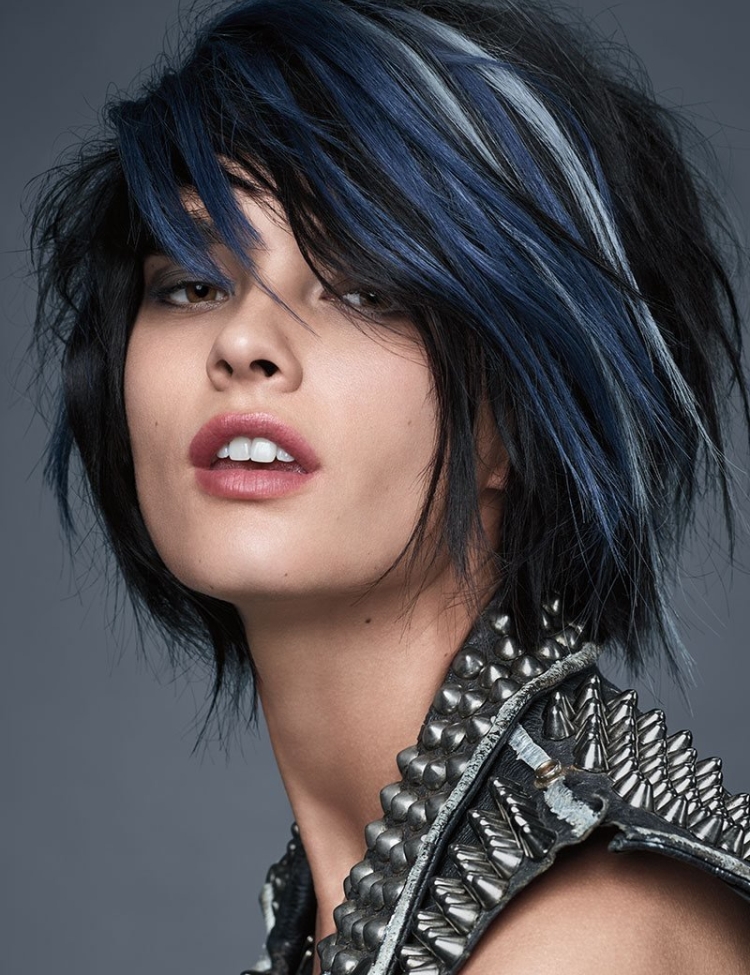

- Zonal and patterned: a certain area is colored. It can be bangs, crown, temples, or even just any arbitrary area. On dark short thick hair, various patterns look original, for example, hearts, stars, drops, etc. Professionals are able to create on the hair even a color that resembles the skin of a tiger, leopard or zebra.
This creative option is perfect for young girls.
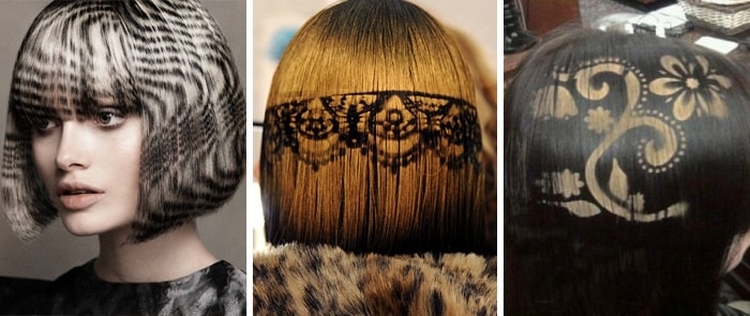
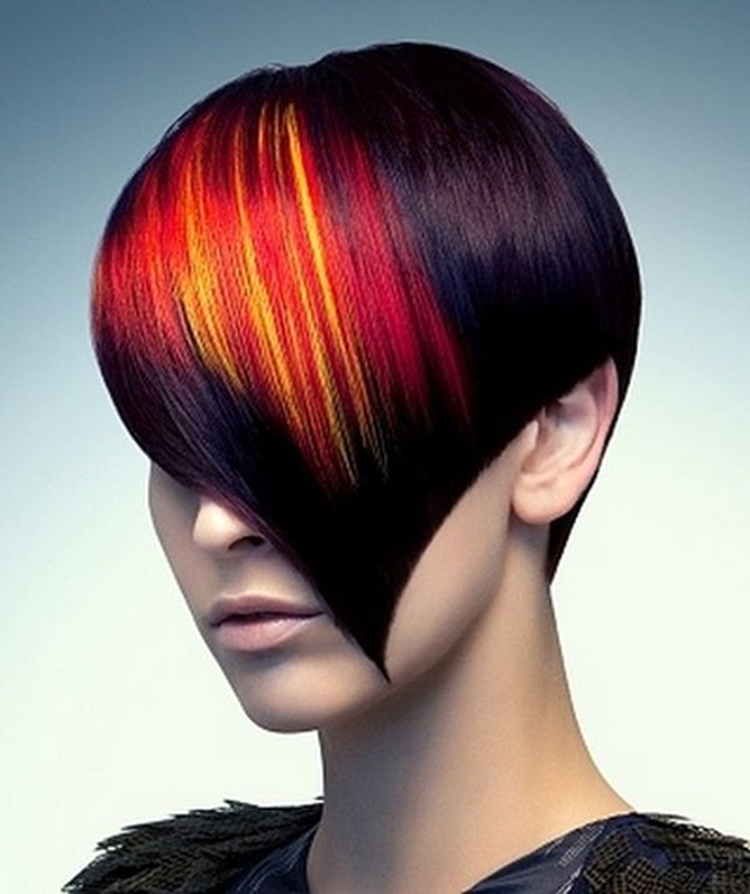
- Neon method involves the use of bright and flashy tones that will shock others.
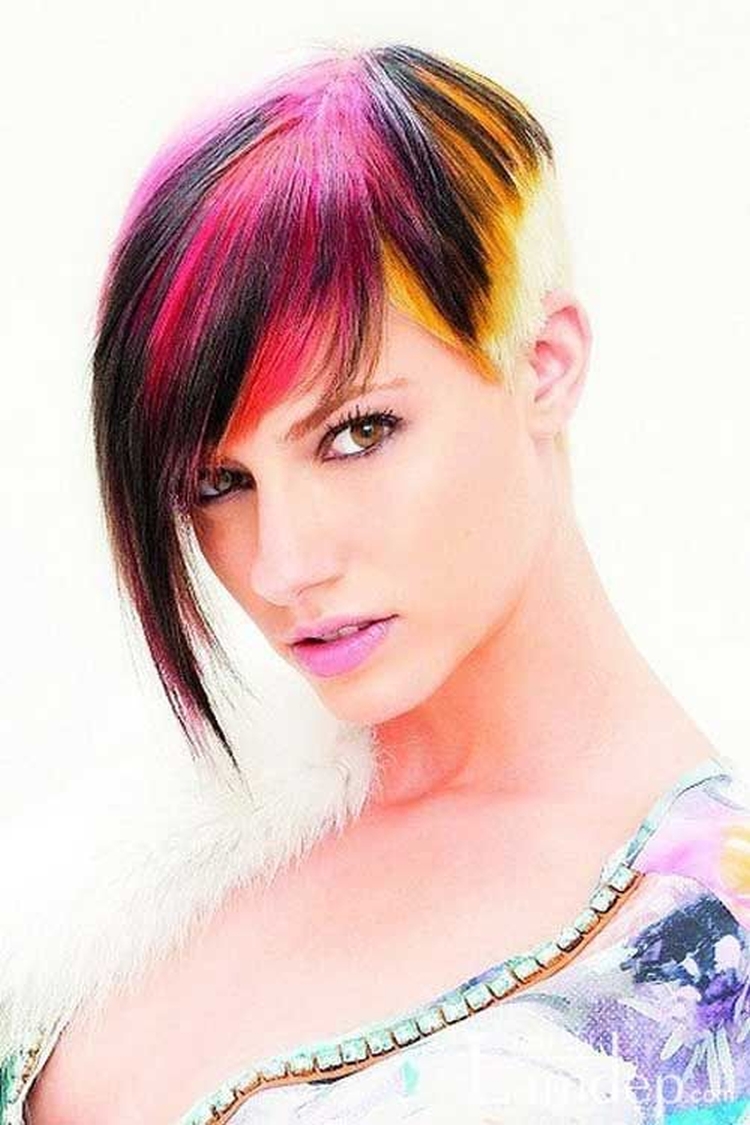
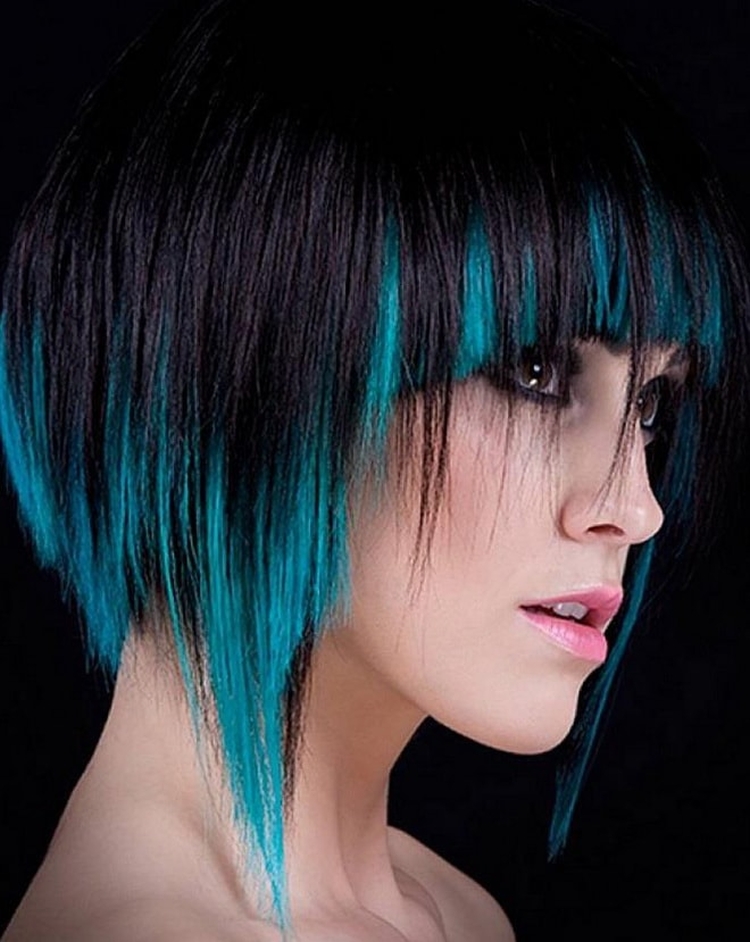
- Bangs dyeing does not affect any of the other sectors of the head. This option is rarely used today or is performed according to a creative method.
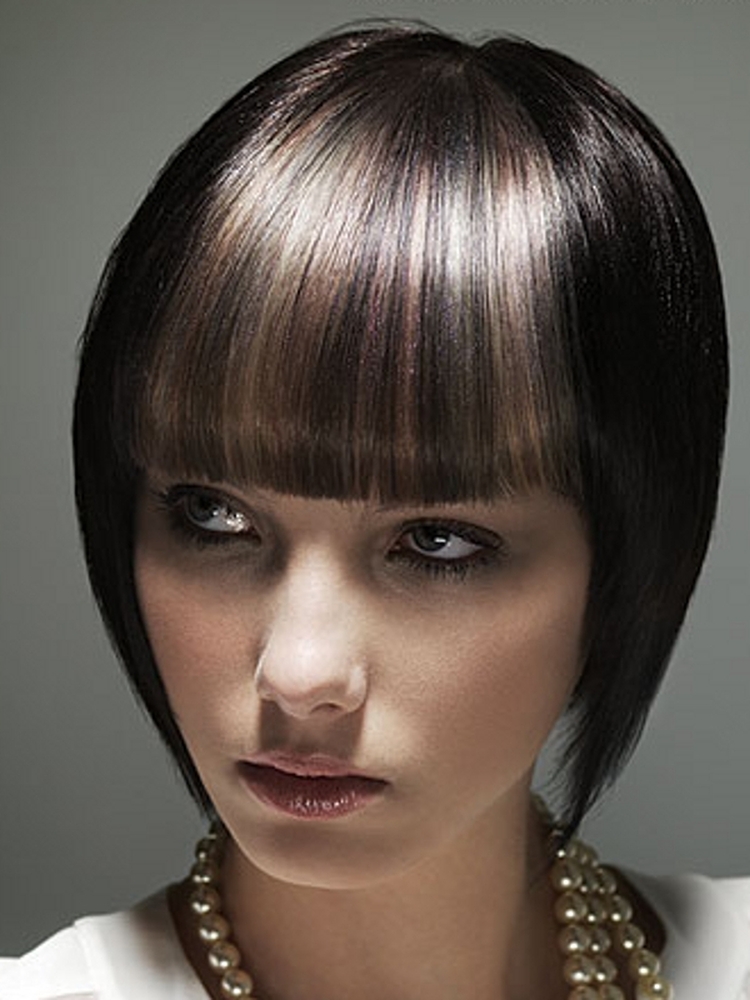
- Transverse involves the transition from one hair color to another from top to bottom. A popular option is the well-known ombre. But the border between colors can be sharp. This is a rather complex technique that is difficult to perform at home.

- Longitudinal coloration is also called vertical, since the strands are colored in this direction from roots to tips. This is an easier technique to master on your own.
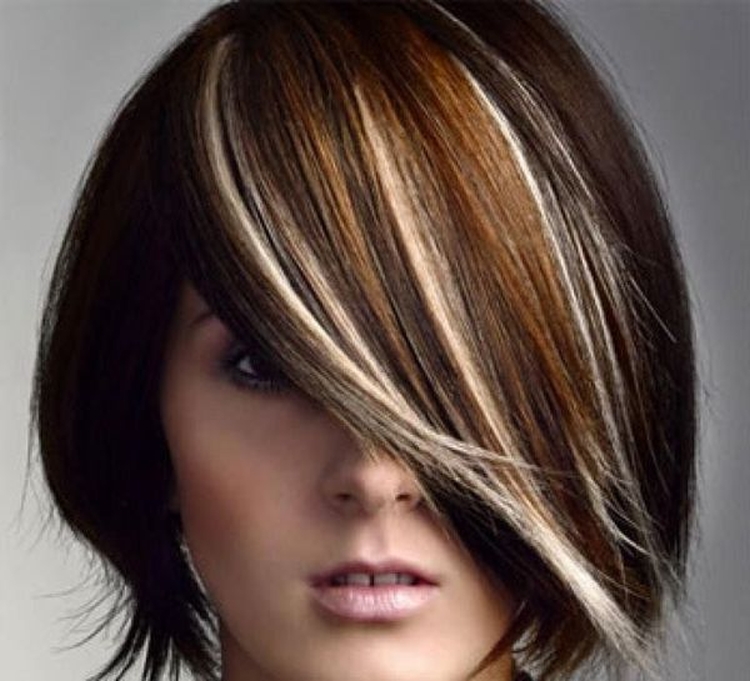
- Multicolor: the coloring technique makes it possible to use up to 15 shades. Strands can be dyed in a variety of colors in any order. In this case, both related and contrasting shades can be combined.
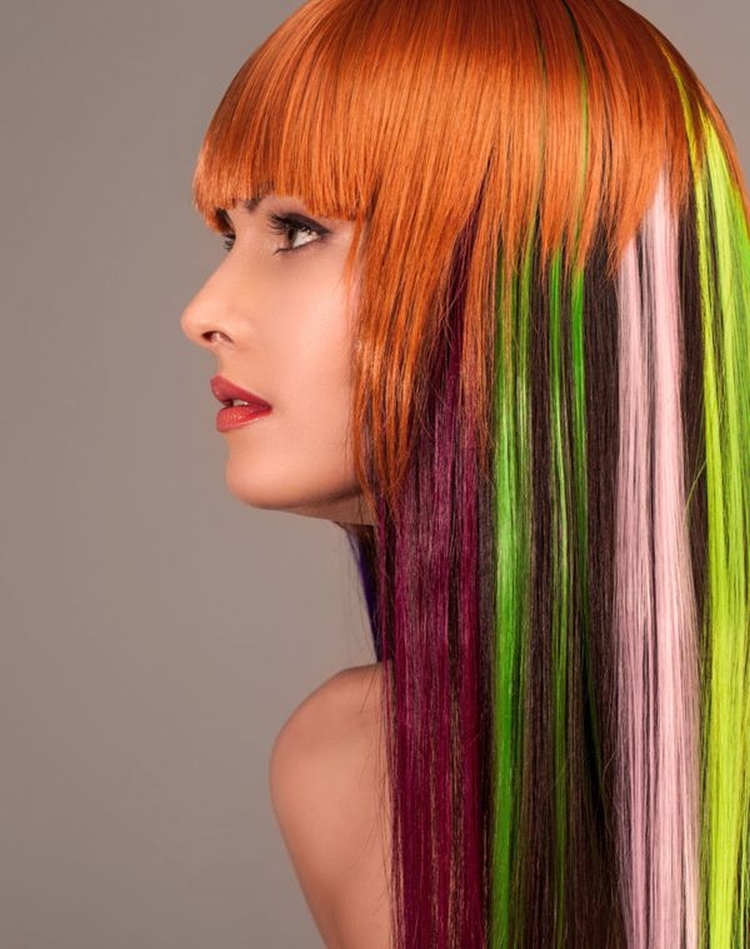
- Complete coloring is performed with a radical change in the original tone of the strands. The successful play of color makes the features more expressive, makes the hairstyle bright and eye-catching. Hair after dyeing looks very beautiful, unusual, interesting.
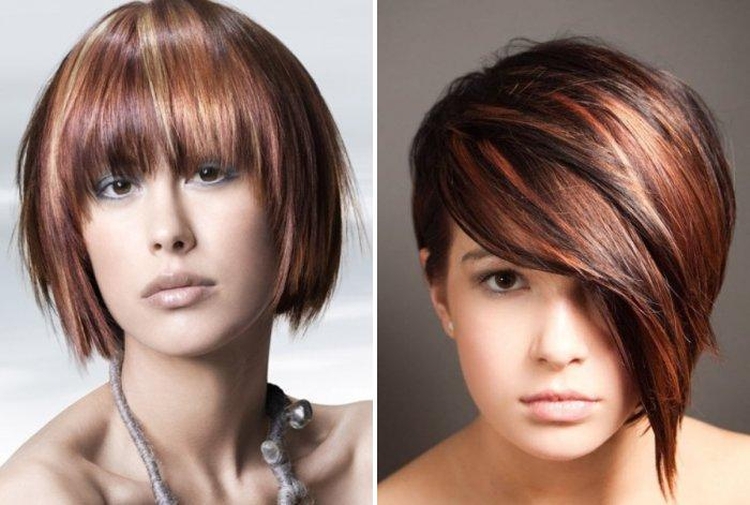
Important! When performing coloring, dark hair will have to be additionally discolored, otherwise the color will not be taken. Light curls will not need this procedure.
Partial: as you can see in these photos, with partial coloring, the base color of the hair is not replaced by a new one, but emphasized by it. The main thing is to choose a color that will look good against your background.
This dyeing method is considered to be more gentle than the previous version, and is ideal for those who are just starting their fashion experiments.
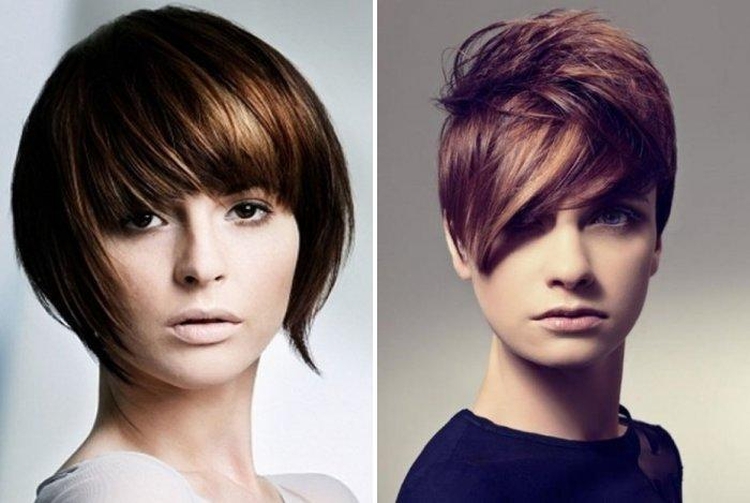
- Complex or multitonal: multi-color hair coloring involves the use of two or more shades. They can be in the same color palette or play in contrast - this is a matter of your tastes.
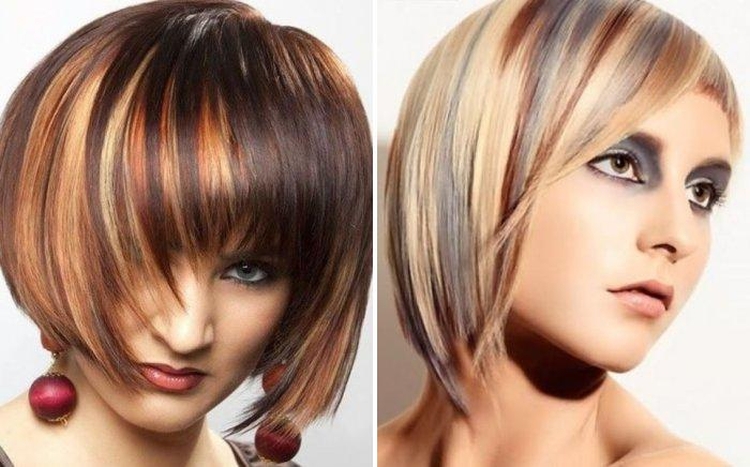
- Coloring hair ends: if you want to freshen up your look without drastic changes, you can experiment with coloring the ends. On dark hair, bleached ends look beautiful. They can also be colored.
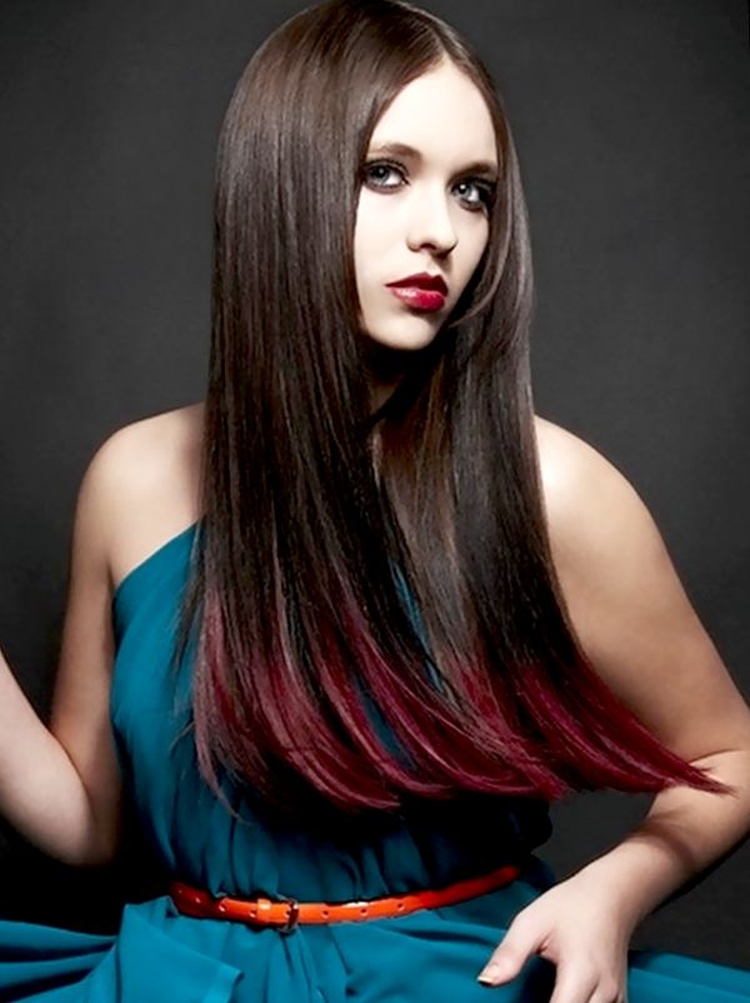
In addition, coloring can be divided into two types: habitual and asymmetrical. Asymmetry looks quite unusual, it allows you to divert attention from facial imperfections. Often, this technique is resorted to in the case of asymmetry of the haircut itself. For example, it can be an asymmetrical bob with a strand instead of a bang, or with a shaved temple.
Underlining these haircuts with coloring allows you to take a fresh look at the haircuts themselves and add creative notes to the women's set.
- Methodology Babylights or the so-called micro-coloring means working with thin strands. It is great for working with soft hair, as it is undemanding to length.
- Ombre allows you to change the base color by 2-3 tones, and closer to the tips. In this case, the transverse borders are stretched.
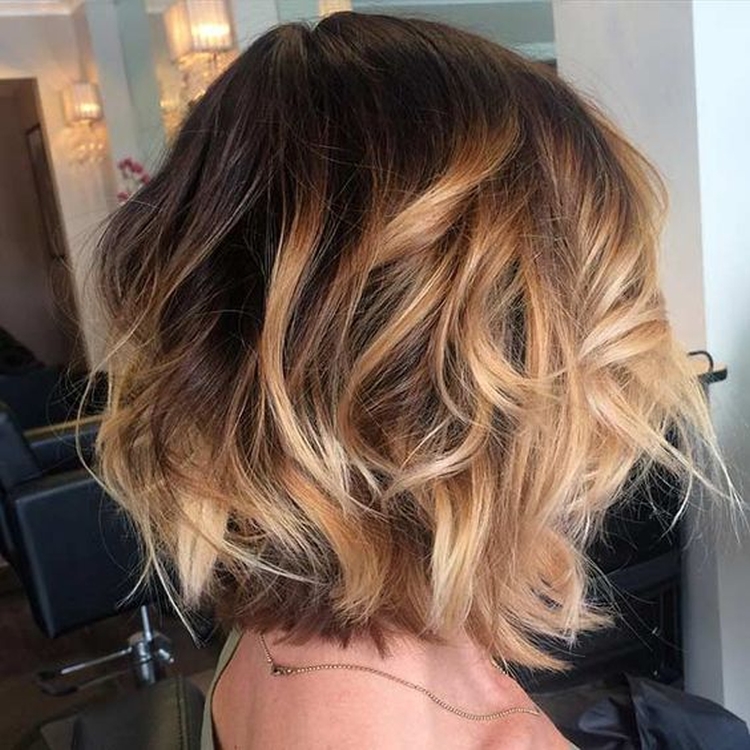
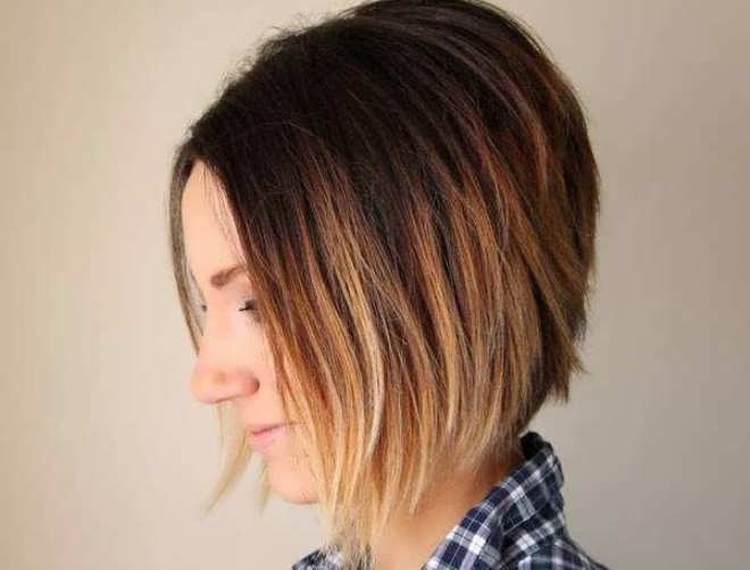
- Sombre differs from the gradient effect in imitation of sun glare, which is created when coloring. It is difficult to make such an option on a short length: at least it should be the length of a square.
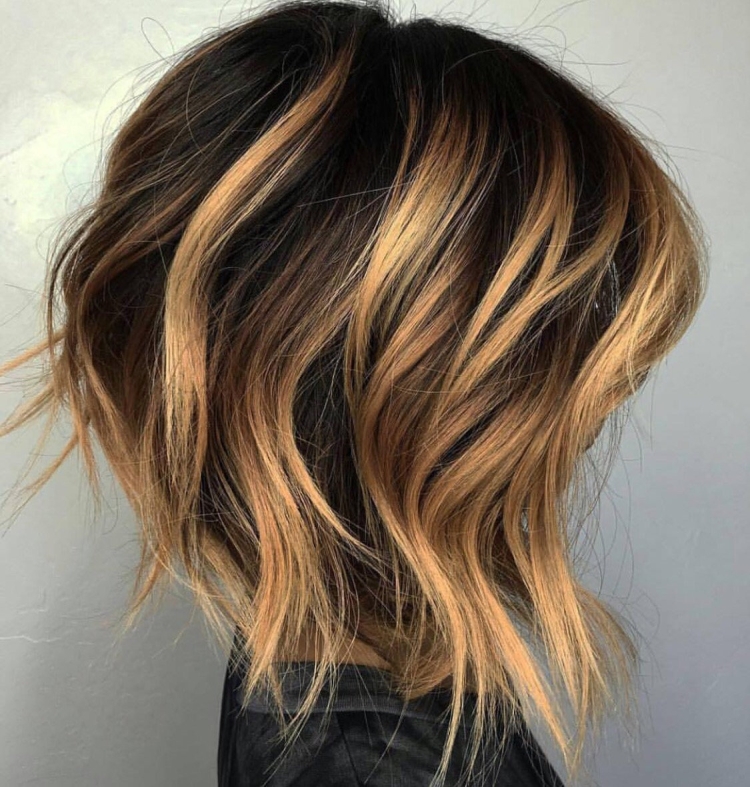

- Bronding it is noteworthy that it looks natural on a short length.
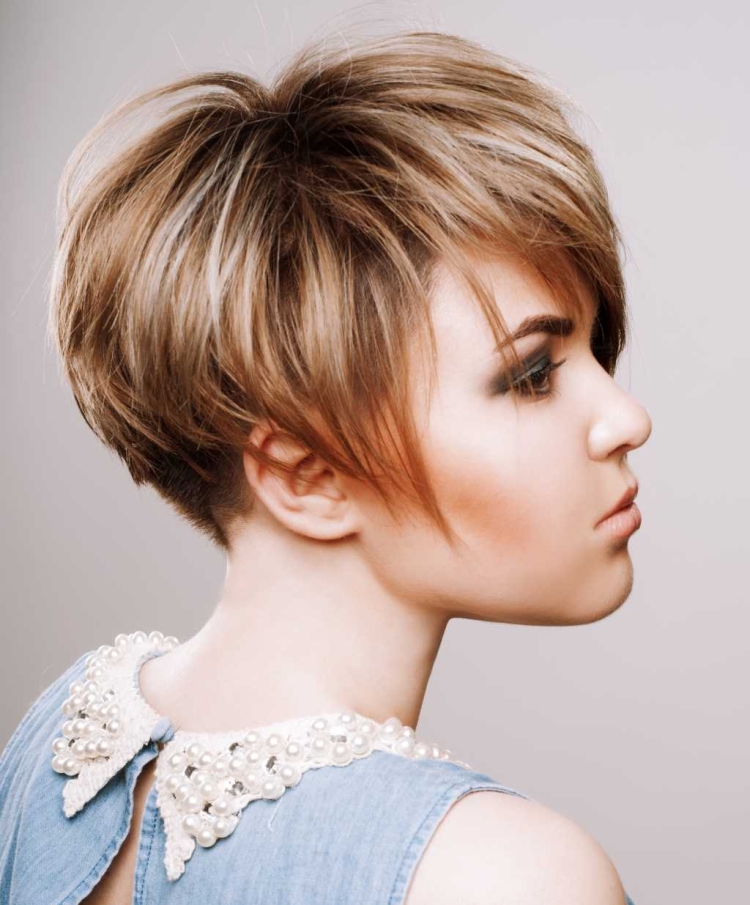
- Crazy Colors - an option for creative youth or beauty bloggers with a craving for shocking.
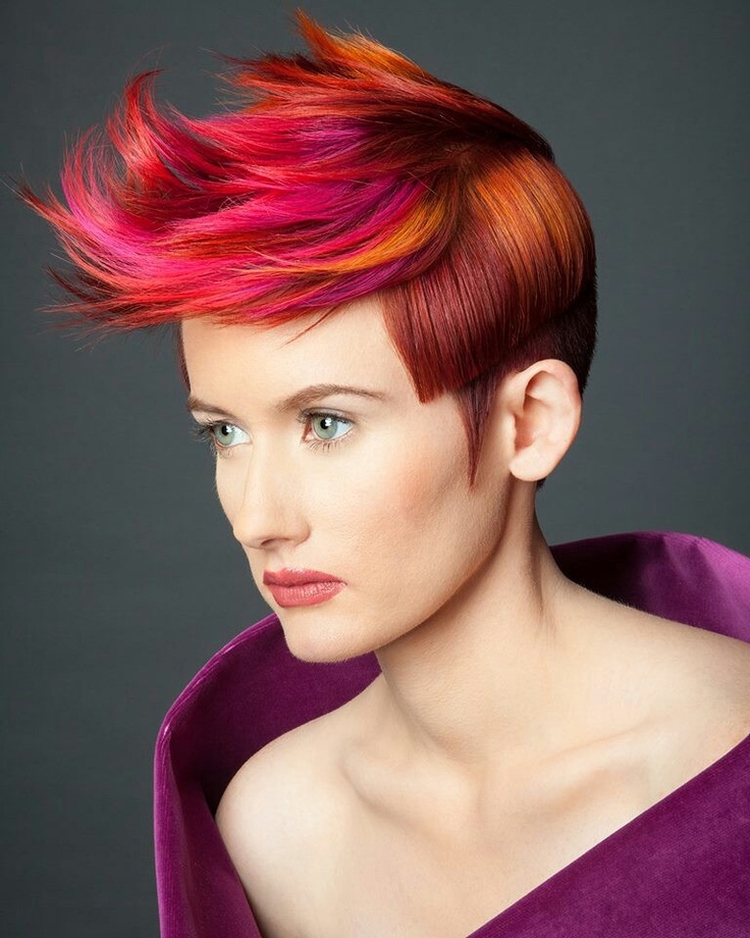

- Pixel painting and is completely unique: on a short haircut, it looks super stylish, and it can take up a very small processing section.
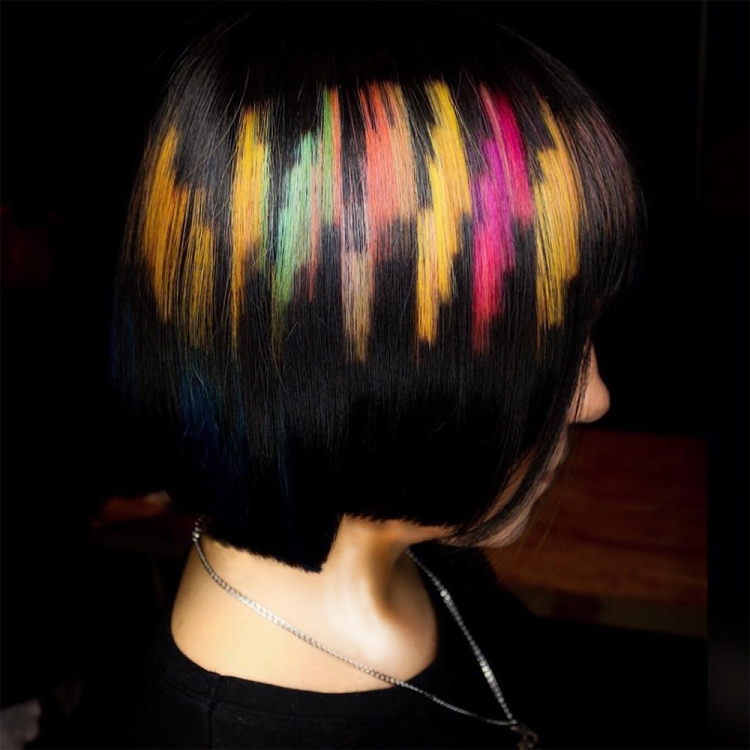
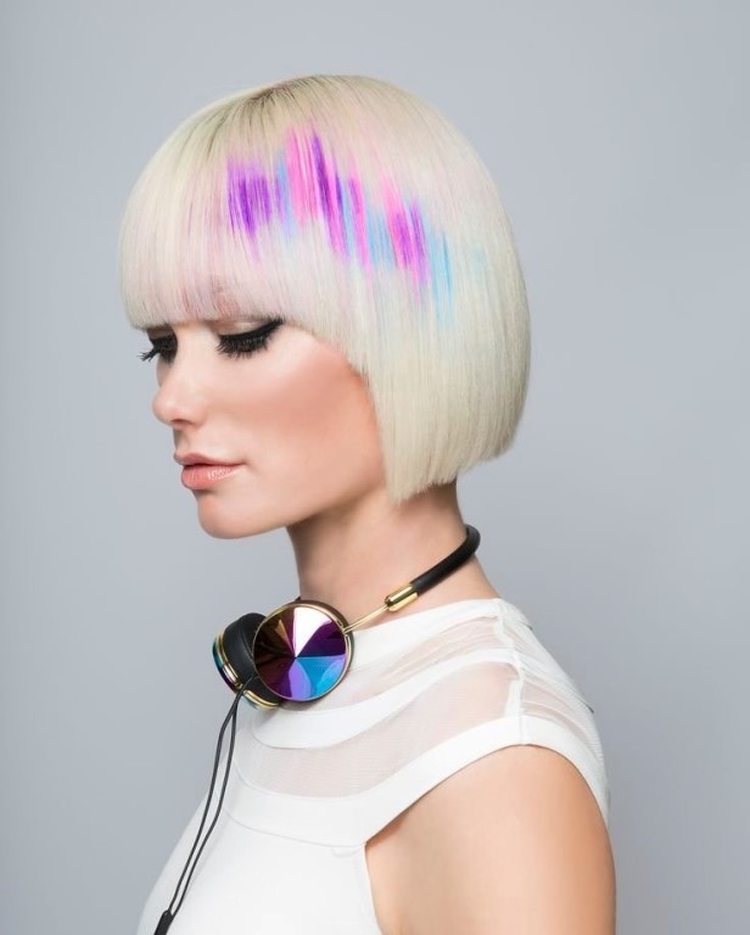
- Stencil method coloring involves the use of a special template, through which the pattern is transferred to a specific section of the haircut.
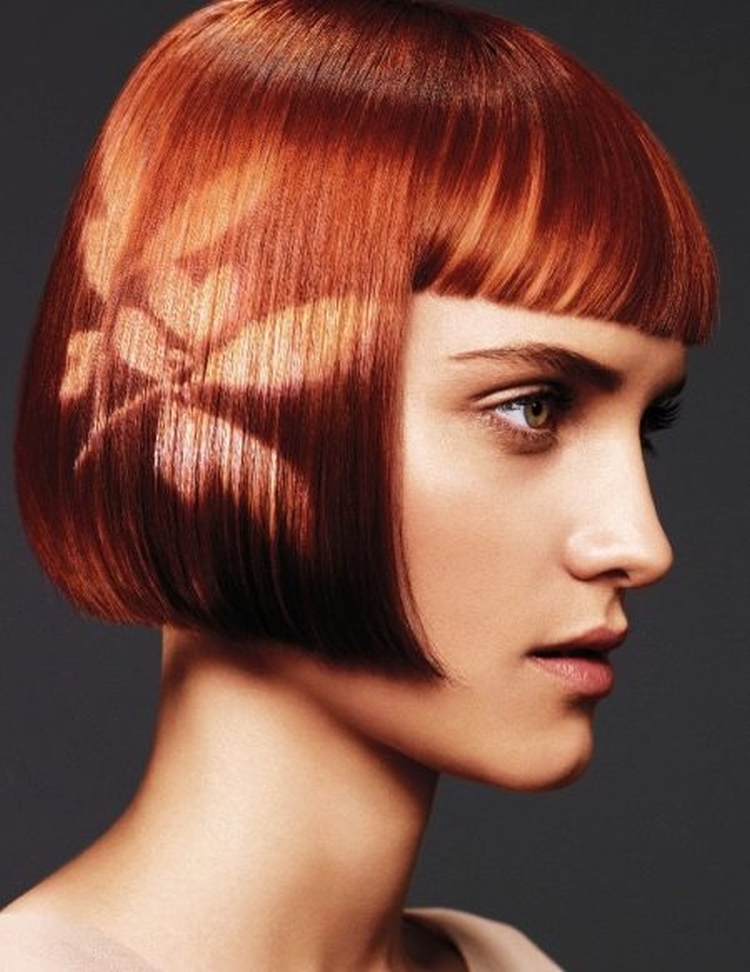
- Peek-a-Boo - a technique for applying pigments without involving the upper strands. This adds not only originality to the hairstyle - this dyeing technique gives the hair volume.
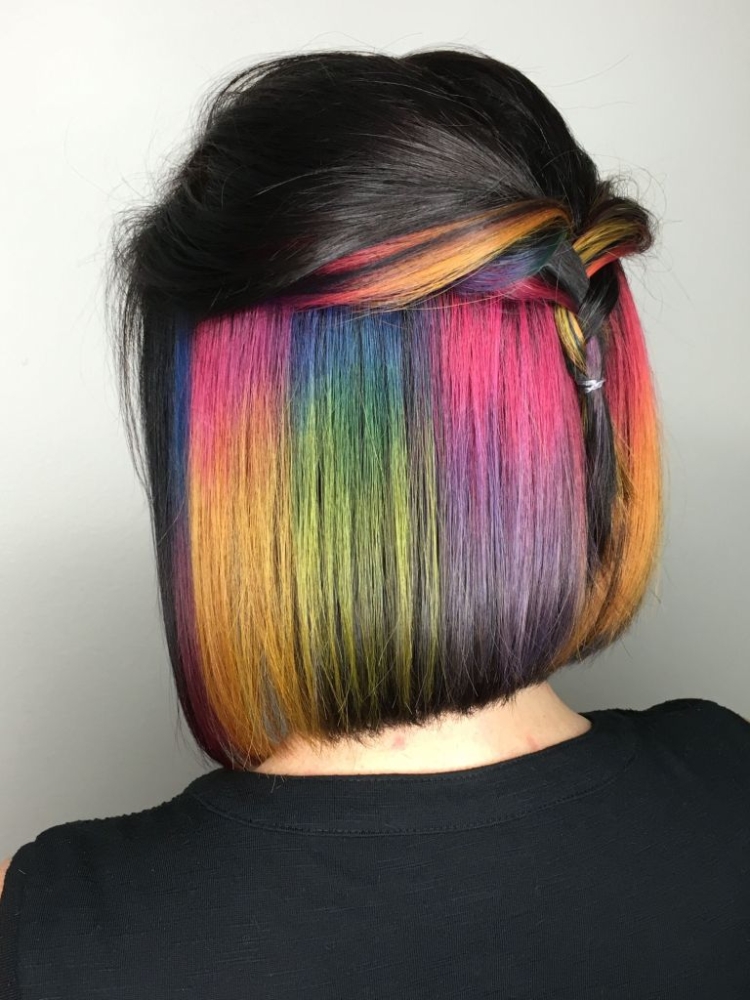
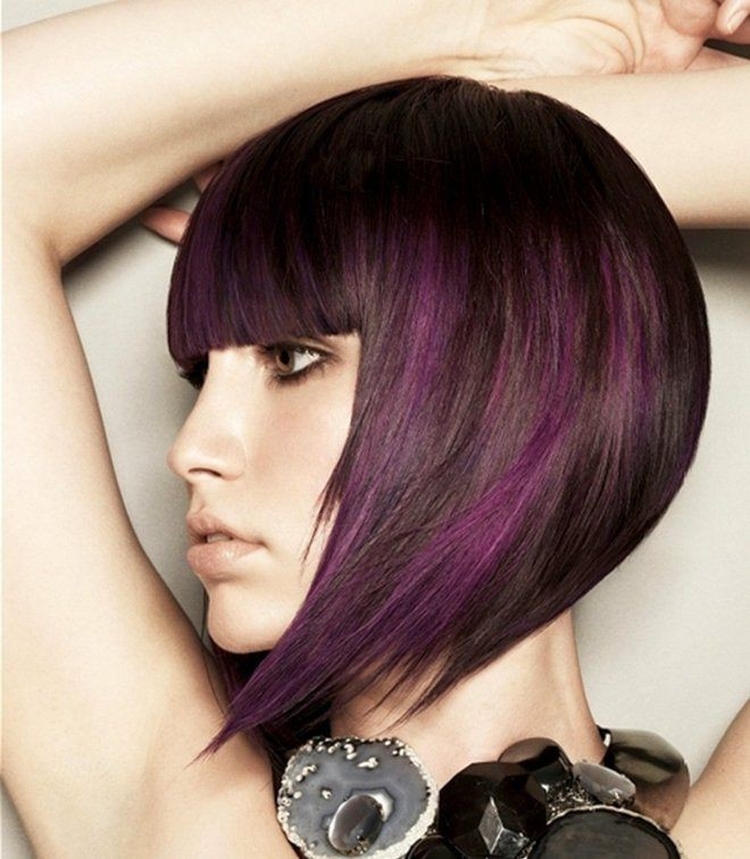
How to choose a color?
The choice of harmonious shades for painting may depend on various factors. For example, these are necessarily fashion trends, features of the color type, the base color of your hair. Today, naturalness is appreciated, and those who are not used to resorting to sharp contrasts can rely on the natural color scheme of hair dyes.
- We must not forget about the need for a certain base for specific paints.
- For example, to take advantage of some shades, blondes may not need preparation, while brunettes will have to highlight curls, sometimes more than once. For blonde women of fashion, you can choose tones of rose gold.
- For beauties with red hair, fashion offers to include shades of copper and gold in coloring. A copper color would be ideal for them.
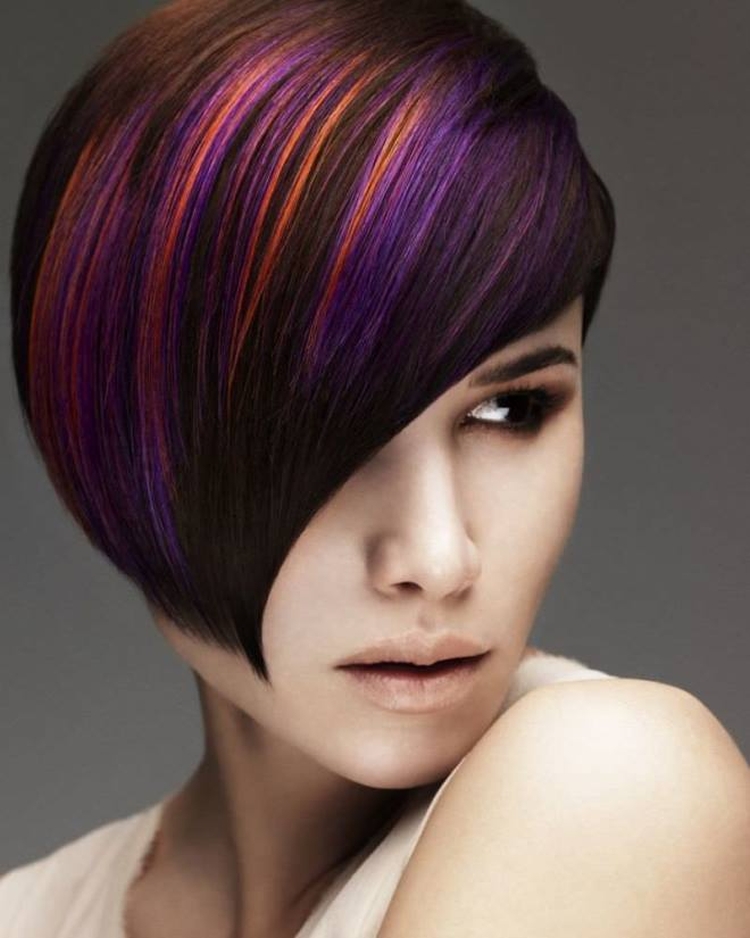
It is more difficult for dark-haired girls, as well as for owners of almost black hair. Today, such colors are considered heavy, and therefore they are often tried to be softened by discoloring at least a couple of tones. The color of the shades is selected taking into account the compatibility with the haircut.
If it is distinguished by the clarity of geometric lines, they need to be emphasized with bright colors. When the haircut is more feminine and soft, it is better to choose tones akin to the base color and perform longitudinal highlights.
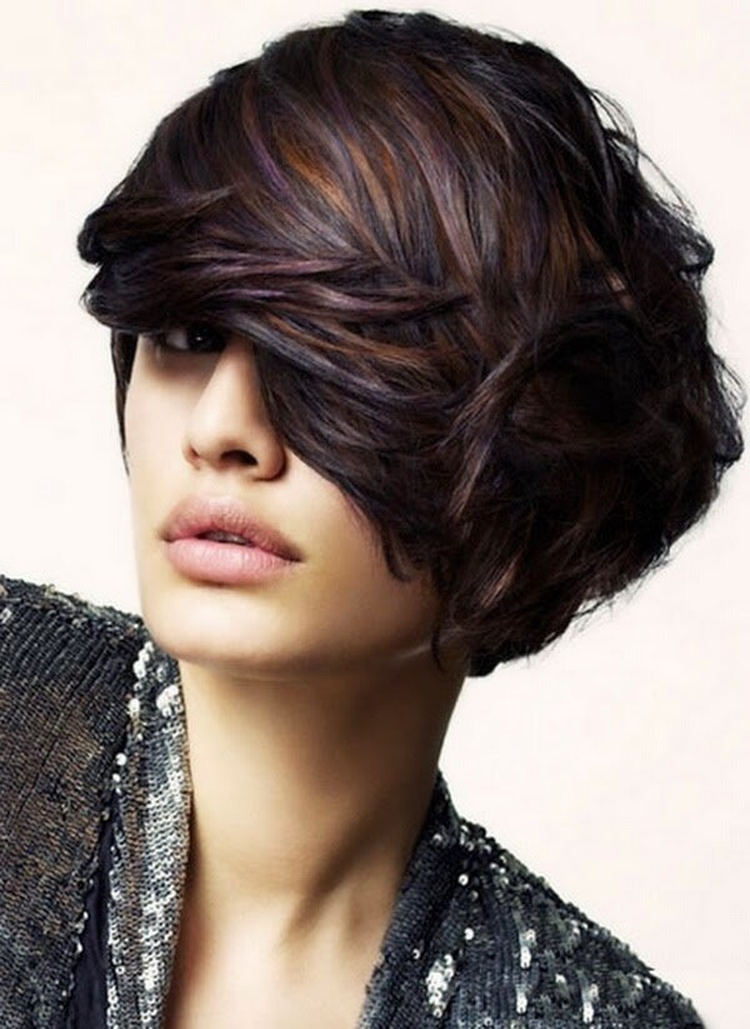
Ash and silver have become fashionable shades of the season. They are great for blondes and fair-haired fashionistas with a cold color type. However, such coloring looks beautiful and effective only in the case of healthy hair and clean skin.
And also blondes can choose shades for painting with blue, caramel, pink, mint tones.
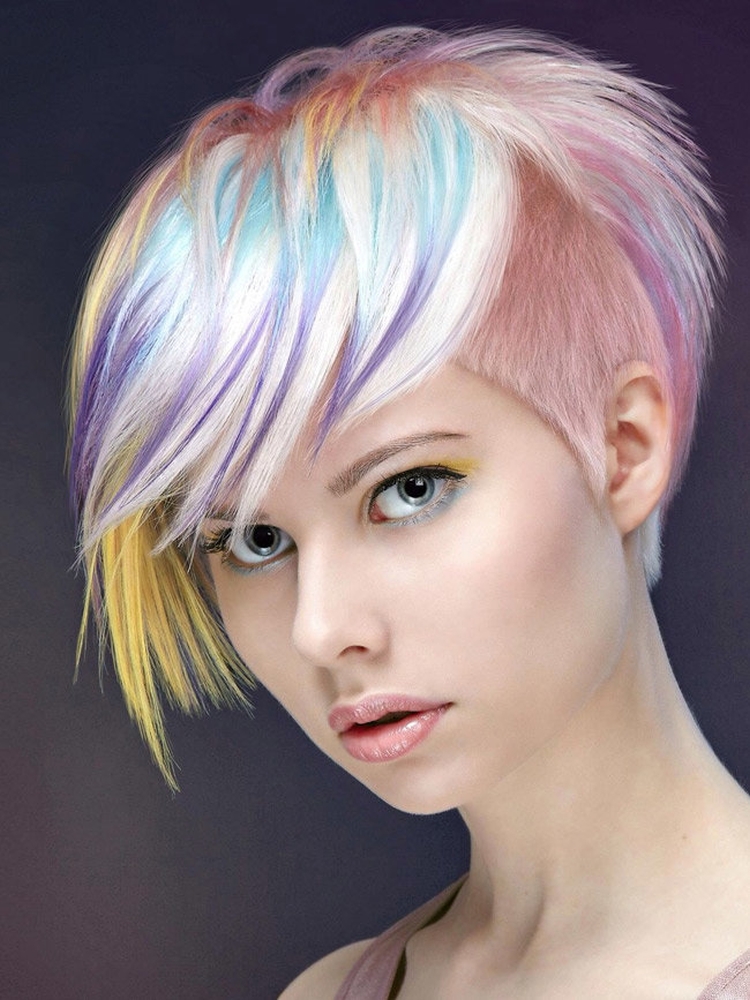
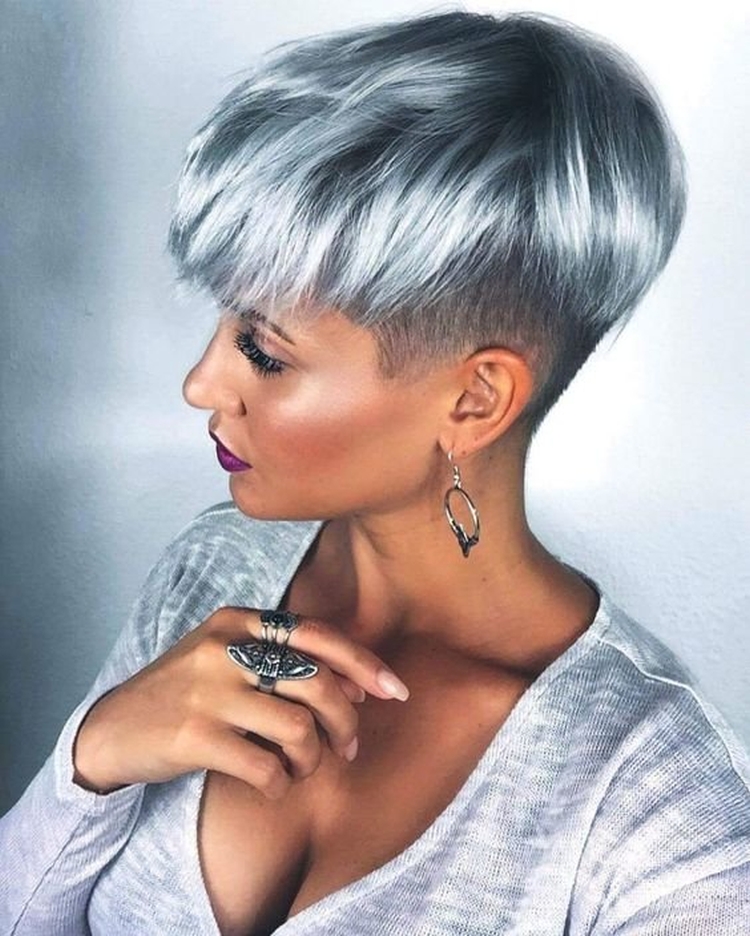
For brunettes and brown-haired women, you can include shades of coffee with milk, as well as amber, honey, cognac tones in the painting. If you want creativity, then bright colors will look better in their image than faded ones. Fair-haired women of fashion can take a closer look at the golden undertone.
However, its appropriateness in a particular image will be more likely to be said by the stylist, because each girl has her own skin tone.

Unlike long hair, coloring on short strands is often performed in a longitudinal way, using a micro-color technique. And in some cases, the number of shades reaches 10. The effect of hair density is achieved through the number of shades and the base color.
For example, to make the blonde's hair seem thicker, you need to add light strands. In this case, short curls can be both darkened and lightened.
For owners of dark hair today, fashion offers to include bright shades of colors in coloring: wine, cherry, purple and blue. Fair-haired women of fashion can choose between a range of natural tones and bright colors, through which you can change your image.
It should be noted: the shorter the hair, the more responsibly you need to approach the issue of choosing shades of dyes.
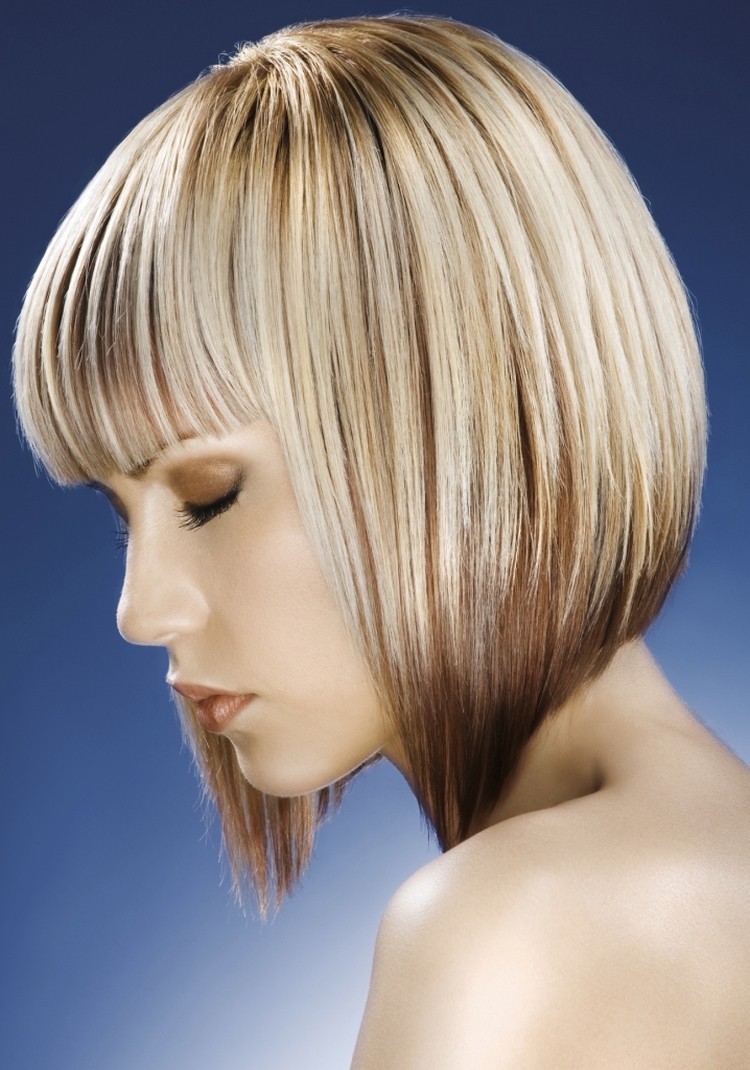

Dyeing technology
It is unlikely that it will be possible to colorize perfectly on short hair at home. Therefore, it is better to go to the salon for the first time and trust a qualified specialist. This will allow not only to understand the essence of the technique, but also to see its implementation by a professional.
For example, dark hair is pre-lightened.
An allergy test should be carried out before dyeing, especially if the dye touches the scalp.
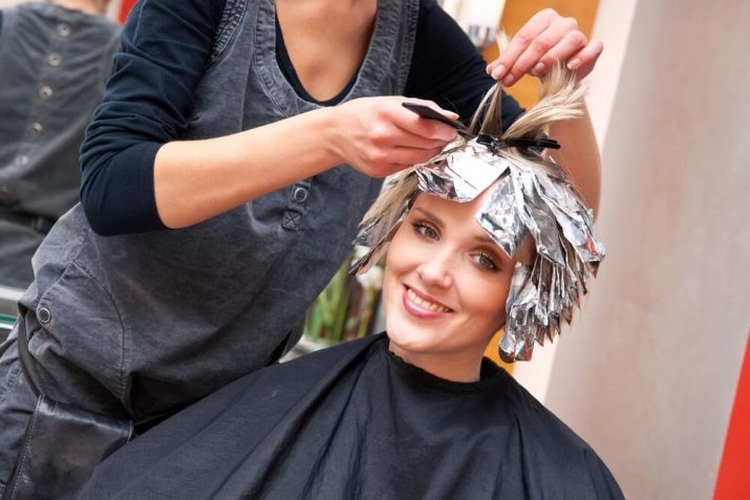
In general, dyeing for short and very short hair is performed according to the standard scheme:
- A shade is selected that is 2 tones lighter in relation to the base one. A 6% oxidizer is taken to it.
- The hair is divided into longitudinal sections, securing each of them with a special clamp.
- The paint is diluted and immediately proceeds to staining, without waiting for its contact with air.
- A small strand is separated, foil is placed under it. Dye each strand from the tip up.
- Next, the paint is stretched, changing the brush to a comb with frequent teeth.
- The strand is wrapped in foil and left until dyed. This is done with all the strands selected for coloring.
- After the time for painting is over, the foil is removed from the strands, the hair is washed with shampoo and conditioner balm.
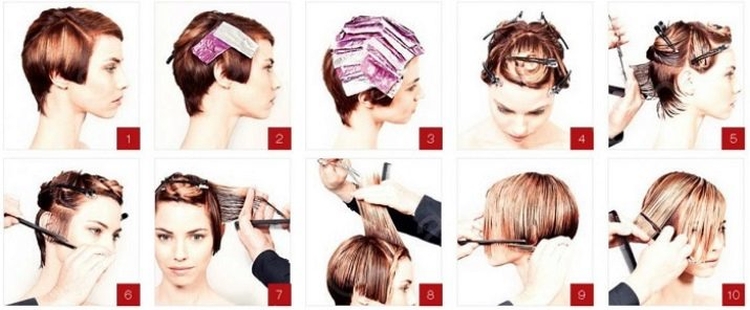
When painting at home, it is worth considering: the duration of exposure to the dye on hair with different structures may vary. For example, thin strands and natural colored hair that have not been dyed before will dye faster.
It is impossible to overexpose the dye on the hair: this can harm the health of both the strands themselves and the scalp.
Care after the procedure
It's no secret that any hair coloring is harmful to their health. They become brittle, thinned and dry. In the first months after dyeing, they will be most exposed to UV rays and temperature.
A caring complex of cosmetic procedures will allow you to quickly restore the health of the curls, saturating them with nutrients and vitamins.
Immediately after dyeing, you can not often comb your hair and pull it tirelessly.You cannot wash your hair every day, and even with too hot water, since the paint is washed off from it very quickly. For washing, you need to purchase a shampoo with a gentle effect, the same goes for the conditioner.
If over time, yellowness begins to appear, you will have to resort to tonics.
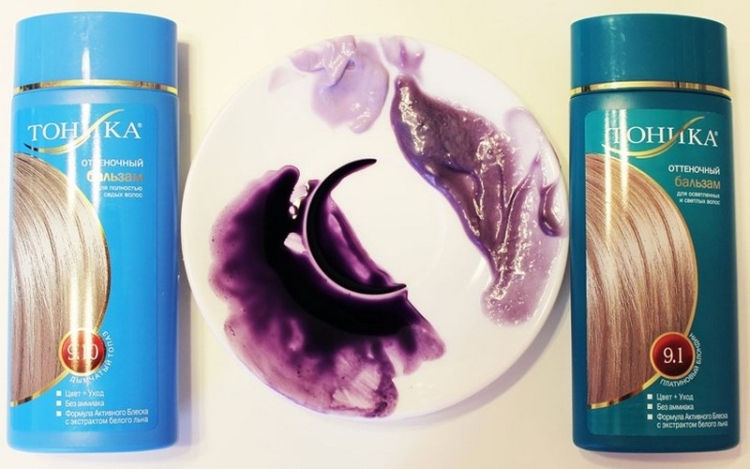

In the first days after staining, you need to use as little as possible means of thermal styling (irons, curling irons, hair dryers). As for the hair dryer, it is better to let your hair dry naturally at least for the first days after washing.
The balm will allow you to give the strands shine, in addition to it, you need to select products for colored hair. They need to be used in dosage, because the hair after dyeing also needs rest.
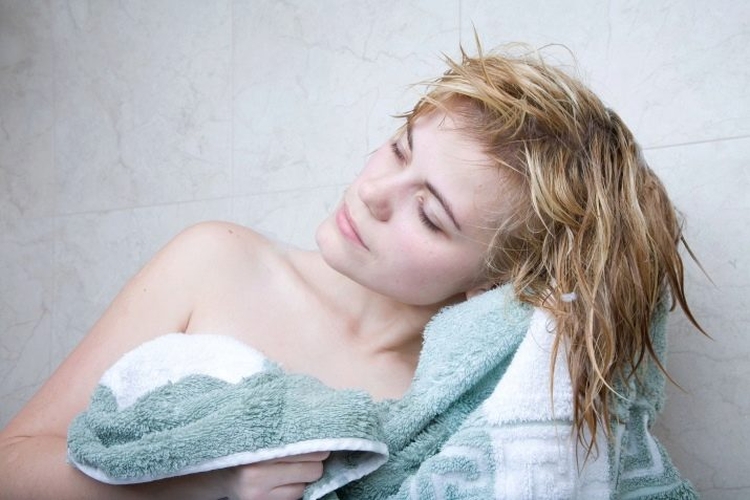
Curly short hair suffers from dyeing more than straight hair. The wash harms them more, turning thick hair into sparse fluff. After painting, they become dry, and without proper care, they can completely fall out. It is believed that masks based on vegetable oils are the best remedy for them.
However, as practice shows, such masks are excellent removers capable of destroying pigment literally in a single application.
Coconut oil has a particularly pronounced effect: it cannot be included in the care of colored strands. As for the use of chamomile broth, it is worth considering: it also brightens the strands. This can cause the strands to fade. They suffer especially when washing off paint with a surface type of staining.
In this case, you can wash your hair with warm water, but not too often: this coloring is enough for about 2-3 weeks.


How to prepare for coloring
It is not recommended to color yourself at home. Firstly, it will be difficult to choose the kind of shades and coloring method that suits your face type. Secondly, technical problems may begin: the hands will start to get very tired, and instead of the desired strand, you can accidentally paint over the unnecessary one. Thirdly, it is difficult to control staining using mirrors.
Attention! Even if a friend agreed to color you, it is still better to think several times whether it is worth the risk. Because there are a lot of nuances in coloring, non-observance of which can lead to a disastrous result.
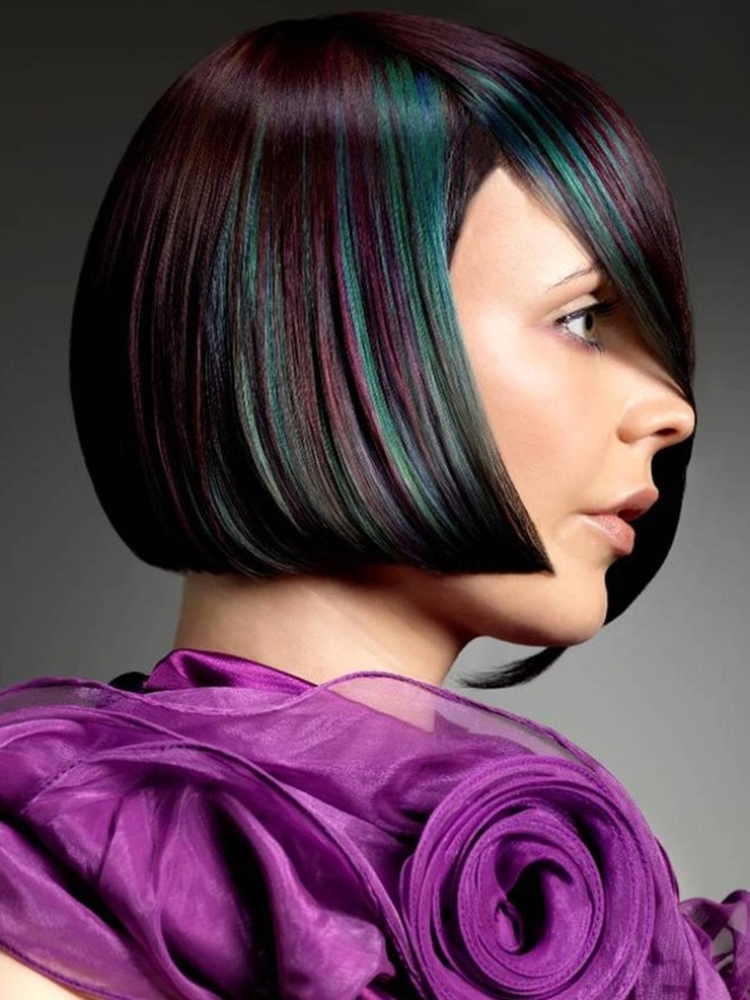
Having signed up for a colorist, you must first discuss with him all the details of the staining. You can discuss them in person or, as many now do, through social networks, instant messengers or Skype. You will be able to discuss the type of coloring that suits you, choose shades, consider various options for the finished coloring (photo from the Internet or the master's personal portfolio).
It is very important for the colorist to understand exactly what you want, because some creative people tend to be bold and experimenting. And it's not a fact that you will like your master's ideas.

Also, the colorist must first assess the condition of your hair, because if it is too brittle, dry or damaged by previous dyeing, you will have to carry out preliminary manipulations.
This can be a haircut (cutting off split ends) or treatment with cosmetics.
Disadvantages of coloring
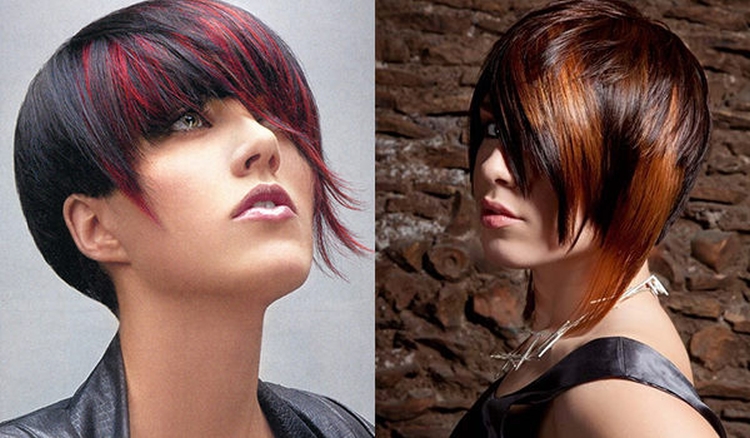
- It is impossible to achieve the required tonality if the hair has been previously permed. After this procedure, about 3 weeks should pass, during which time the hair structure will be restored.
- Sometimes, in order to obtain the desired shade, the hair has to be bleached. This is painful for the hair, therefore, before the main coloring, they need to rest for 3-4 days after bleaching.
- It is impossible to completely paint over the hair roots.
- The main disadvantage of the fashionable procedure is that good coloring is possible only in the salon; with home coloring, the result will not be so high-quality.
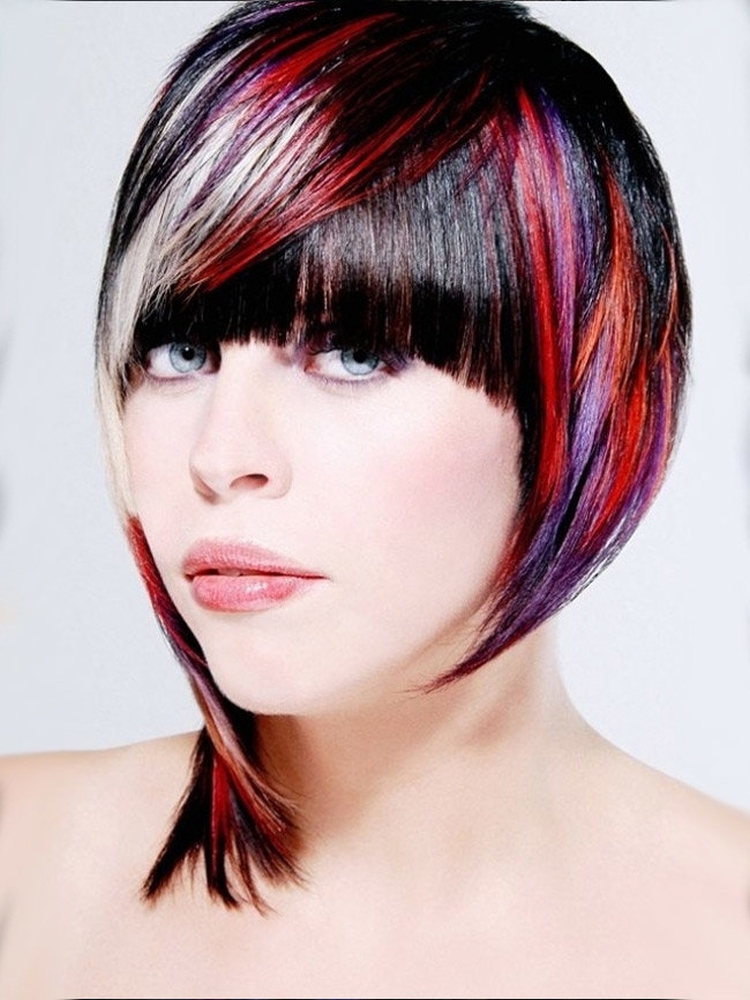
Precautionary measures
Before painting, you must make sure that there is no allergy to the paint. To do this, a little coloring agent is applied to the elbow fold, if after 5 minutes.the skin will not turn red - the paint can be used.
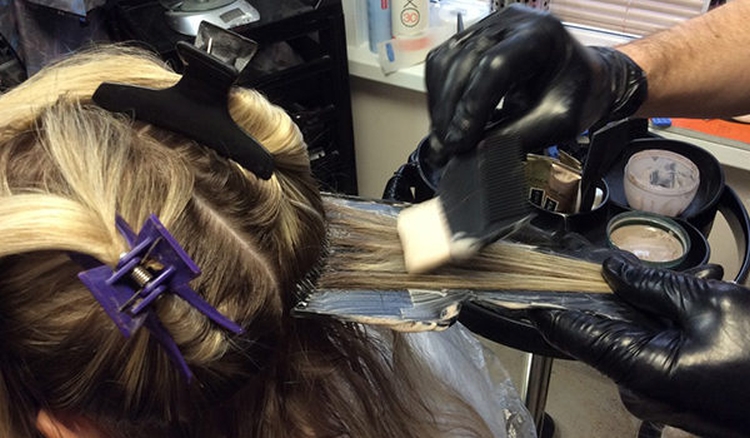
Special care is required for coloring on curly and dry, naturally weak hair. They cannot be discolored, this will make them even weaker and any staining for them is stressful.
Therefore, the hair must be maximally moisturized and nourished with special products before and after dyeing, as well as protected from direct sunlight.
It is not worth saving on such a complex procedure as coloring. It is better to entrust the creation of your image to a real professional, giving him complete freedom of action. The imagination and skill of the stylist can create a completely unique image.
To find a tonality of color that will match and look great, he must have a real artistic taste and professional experience.

Also, do not forget about the daily self-care of your hair, use gloss to refresh the paint and fixatives to preserve the hairstyle.
If you follow these rules, a toned haircut will always be a source of self-confidence and increased attention of others.
How to color with henna
For home coloring, henna, a natural and safe dye, can be used. But you need to take into account that it is very persistent, and it will be problematic to get rid of the resulting shade in the future. Features of using henna for home coloring are as follows:
Henna is diluted with hot water (up to 85 degrees) and mixes well. The result should be the consistency of sour cream. Let it cool so as not to burn the skin.
Henna is applied in the same way as ordinary dyes. After applying, the strands need to be wrapped in foil.
The exposure time determines the final result, but in any case, you need to leave it for at least an hour. You can visually control the staining. When the desired shade is obtained, the composition is thoroughly washed off with water without shampoo.
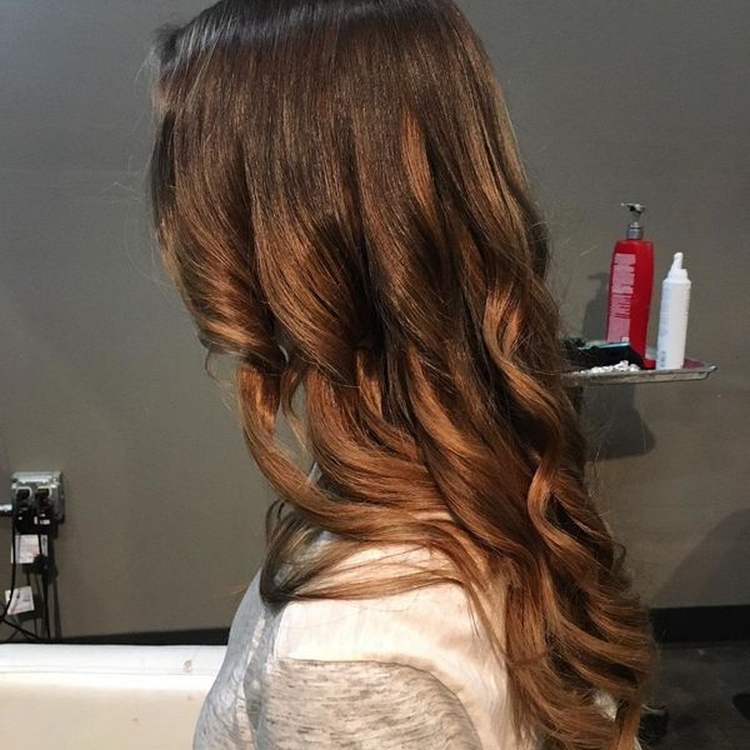
Conclusion
Coloring is a great way to change your image. The variety of its options allows you to choose the right technique for any girl. The procedure is quite complicated, and it is better to entrust it to a good specialist.
